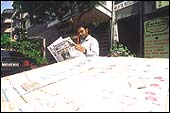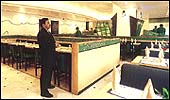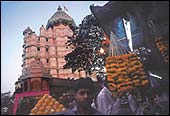








|
BACK OF THE
BOOK
The Day The Buzz Died
The restaurants and hotels are empty. The
stockmarket is comatose. Life seems on hold. From shanty town to
skyscraper, an uncomfortable hush settles on the city of dreams, Mumbai.
By Abir
Pal
 Buzz. The
definition is a pleasant intoxication or vibration, depending on whether
you use it as a noun or a verb. Every entrepreneur, salaryman and woman,
performer, stockbroker, financial analyst and paanwallah knows the buzz.
It is an energy that pulses through Mumbai, urging them onward in their
quest for prosperity. It's in the humid air, it crawls into the blood of
its people. The buzz defines Mumbai as a city of vigour, a city of oomph. Buzz. The
definition is a pleasant intoxication or vibration, depending on whether
you use it as a noun or a verb. Every entrepreneur, salaryman and woman,
performer, stockbroker, financial analyst and paanwallah knows the buzz.
It is an energy that pulses through Mumbai, urging them onward in their
quest for prosperity. It's in the humid air, it crawls into the blood of
its people. The buzz defines Mumbai as a city of vigour, a city of oomph.
A funny thing happened. The buzz is gone.
Suma knows it. "Mat puchiye saab, ek dam
mandi hain (don't ask, everything is dead),'' he sighs, spitting out his
wad of paan. On a typically hot afternoon, the 20-year-old's stall of IPO
application forms is narcose, like the air in the city. He's the only IPO-form
vendor in the quiet of the street that once had a fish-market like air to
it. Suma displays application forms for fixed deposit schemes, corporate
bonds, mutual funds, government saving schemes. Everything, except the
once ubiquitous IPO form. Behind him, the torpidity flows up the narrow
stretch of that path of gold they call Dalal Street. "I just sit here
and wait for the next issue," laments Suma, who must now get by with
Rs 1,000 a month, about a fifth of what he used to earn until last year.
Like a fog, the leadenness has spread through
the city, obscuring its vision and dreams. Welcome to post-stock crash,
post-tech crash, post-terrorist crash Mumbai. Restaurants are deserted,
there are long lines of waiting cabs, luxury hotel rooms are going
abegging, flights to and from the city are only 60 per cent full, and
night clubs have all but done away with cover charges on weekdays-they're
lucky if they get customers. Today, commuters still gush forth like storm
water from Churchgate station every morning, but the spring in their steps
is gone. Jobs are being slashed, the real-estate market is stagnant,
people are sluggish, uncertain and unwilling to spend. And the tourists
and the travellers have deserted Mumbai, even the richest of them.
|
Everything's
Down |
|
IPO-Form
VENDOR
(Avg Monthly Income) |
 |
THE GREAT
WAIT
As the stock business slackens, a way of life falters.
2000: Rs 4,000
2001: Rs 1,000 |
|

|
COOL
CABS
(Avg Monthly Income)
THE HEAT IS ON
Competition has grown and customers have vanished.
2000: Rs 9,000
2001: Rs 6,000
|
 |
HOTEL
OCCUPANCY
(Avg Monthly Income)
THE BIG EMPTY
The tourists are gone, and banquets have dried up.
2000: 80%
2001: 65%
|
 |
| ... Except
For Faith
TEMPLE
COLLECTIONS
(Avg Monthly Income)
PRAISE THE LORD
At the Siddi Vinayak temple, the prayers grow.
2000: 59.81 lakh
2001: 62.20 lakh
|
In vice president Sanjiv Malhotra's elegant
wood-paneled office, leafing through the latest Cigar Aficionado and Wine
Spectator, any economic slowdown seems far far away. But the numbers tell
a different tale. Room occupancy at the 1,000-room Oberoi has gone down
from 80 per cent to around 60 per cent. Non-resident revenues, events,
corporate dos, IPO meets have all but disappeared. "It's to a large
extent psychological: when your notional wealth or net worth takes a
battering, spending is bound to get affected," says Malhotra,
straightening his Salvatore Ferragamo tie.
Ravi Dubey, senior vice president at the
other large south Mumbai hotel, the iconic Taj Mahal, is at home nursing a
nasty case of flu. ''Yes, there's a definite lull in business and it
couldn't have come at a worse time-right at the start of the October-March
peak season,'' he says on the phone. Average occupancy at the Taj Mahal
Bombay has dropped 15 per cent and food and beverage revenues have been
hit bad. Dubey won't reveal numbers. While the industry is abuzz with news
of hotels being forced to slash rates, both Dubey and Malhotra deny any
aggressive price cutting. ''Of course, rates are always negotiable for
corporates and regular customers, and even upgrades are routinely given
for regulars, but these have nothing to do with the slowdown,'' says Dubey.
However, ring up the Taj and you'll be instantly offered an Rs 8,800 city
view room at Rs 6,440. And at Oberoi Towers, a standard Rs 8,800 room is
today available at a mere Rs 6,850.
It gets worse down the food chain.
''It's never happened before-it's the first
time in the last 30 years that revenues have been so hard hit,'' says
Arjun Ramani, 62, the affable General Manager of West End Hotel, sitting
in the 53-year-old hotel's breezy but largely deserted lobby. Ramani, a
hotel-industry veteran, pulls out a leather-bound ledger. The highlighted
numbers jump out: yearly room revenues are down from Rs 5.09 crore to Rs
4.99 crore, restaurant revenues from Rs 2.01 crore to Rs 1.67 crore.
Beside him in the huge black leather settee, managing director Sunder N.
Awatramani says he's wondering how to woo back clients. Occupancy at the
80-roomer has slipped to 57 per cent. Foreign tourists, for whom the
old-world charms of the West End were a big draw, have virtually
disappeared. Even regular business travellers seem to be restricting
themselves to short, sporadic visits.
This is the same city where a year ago you
would be lucky to land a table at lunchtime. Bankers wouldn't think twice
about blowing up thousands on cognacs and Cubans. Coffee shops were full
of yuppies feting the latest dotcom deal and swanky new malls were
bursting with determined shoppers. The Sensex was up, jobs were aplenty
and there was optimism in the air. In the teeming trains, it seemed
commuters could only talk about the hottest stocks on Dalal Street, their
new flat, and the great future ahead.
Gaylord in Churchgate, with its swaying
potted palms and cool marble top tables, was one of those places where
brokers and corporate honchos schmoozed about what would be. It was once
difficult to get in without prior reservations. Today, general manager
Noel D'Souza urges you to take your pick of table. "Even a year back
we were serving one and a half times the cover. Today, we're lucky if all
our table get filled". Revenues are down by at least 20 per cent.
"That extra drink, the appetiser-these have been the biggest
casualties; not to mention the complete disappearance of the corporate
yuppie who often splurged on lavish cocktail lunches," says D'Souza.
On the street outside, M.G. Dhillon. 50, is
comatose in his stationary air-conditioned, blue Cool Cab. After 30 years
of ferrying people, he thought he would limit himself to foreign tourists
for a guided tour of the city. That fetches him an easy Rs 600-800. But
his monthly income has dropped by a third to Rs 6,000 and really, he'll
pretty much go where you want him to. And while demand has stagnated,
supply has gone through the roof. Today there are 850 Cool Cabs alone; not
to mention the number of regular taxis that have doubled to 54,000 in the
last six years.
Kamal Kedia, Managing director, RNK Car
Rentals has the same grouse-poor demand. He's standing outside his
Prabhadevi office watching one his 350 strong fleet- which includes BMWs,
Mercedes Benzs, even a six-door Volvo limousine-being serviced. Kedia, who
started out 30 years ago with five cars today has offices in four cities
catering to leading hotels, corporates and government agencies. Two years
back he notched up a yearly turnover of Rs 7 crore. This year with
occupancy plunging 60 per cent, he says he'll be happy to cross Rs 6.5
crore.
It makes no difference that it's the festive
season. At the Heera Panna market for foreign goods in Haji Ali, there are
few takers for the flat screen TVs, DVDs, colognes and Ferrero Rocher
chocolates. While throngs still move from shop to shop, the
"conversion" rate is rather low, the shop keepers lament.
If there's one thing that's flourishing, it's
the temple donation box. Average monthly incomes at the colossal
Siddhivinayak Ganapati Temple have risen to Rs 62.20 lakh, from last
year's Rs 59.81 lakh. The temple trust's total investments currently stand
at a whopping Rs 36 crores, maybe more. Can the buzz live again? That-Mumbai's
people seem to agree-is up to God.
|
TREADMILL |
|
Look Ma, No Legs  At
my suburban mumbai gym you'd see some of these hunks strutting
around self-consciously: extraordinarily huge biceps, massive pecs
with deep cleavages and upper back muscles that restrict normal arm
movements while walking. Every gym has these Arnold Schwarzenegger
clones. They're usually in cutaway tank-tops, or better still, bare
chested, flexing their biceps or flaring their chests near the
water-cooler, in front of the mirrors or in the sauna. Heap big
body-builders these. But almost invariably, their legs are a total
giveaway. Thin and spindly, in complete contrast to the
well-developed upper bodies, they bear embarrassed testimony to how
most people tend to neglect lower body exercises. Next perhaps only
to boring abdominal crunches, exercises for the legs are the most
commonly overlooked ones. Want proof? Ask 10 gym regulars whether
they've ever done squats. You'll be surprised how many say no. At
my suburban mumbai gym you'd see some of these hunks strutting
around self-consciously: extraordinarily huge biceps, massive pecs
with deep cleavages and upper back muscles that restrict normal arm
movements while walking. Every gym has these Arnold Schwarzenegger
clones. They're usually in cutaway tank-tops, or better still, bare
chested, flexing their biceps or flaring their chests near the
water-cooler, in front of the mirrors or in the sauna. Heap big
body-builders these. But almost invariably, their legs are a total
giveaway. Thin and spindly, in complete contrast to the
well-developed upper bodies, they bear embarrassed testimony to how
most people tend to neglect lower body exercises. Next perhaps only
to boring abdominal crunches, exercises for the legs are the most
commonly overlooked ones. Want proof? Ask 10 gym regulars whether
they've ever done squats. You'll be surprised how many say no.
If you're one of those, here's a
primer on how to begin. Stand up. Now, move your feet so they're
just slightly wider than shoulder width apart and toes pointing out
(just a bit). Grab your legs just above the knees (the lower quads),
right hand on right leg, left hand on left. Take a deep breath. Keep
your back straight and raise your hands out straight in front of
you. Keeping your weight on your heels and your feet flat on the
floor, lower yourself another 10 inches.
With your hands still in front
of you, lift yourself to an upright position using your upper leg
muscles. Lower yourself and repeat. There you are.
After a couple of weeks of
free-hand (sans weights) squats, graduate to barbell squats. If
you're using a squat rack, position the safety bars of the squat
rack at a spot just slightly below your shoulders. If you're using a
solid pin squat rack, put the bar on the pins nearest your shoulder
height. Step up to the empty bar and wrap your hands around the bar
in a comfortable spot. Most people end up with their hands about a
foot wider than their shoulders. For back squats, step under the bar
and bring your upper body backwards into contact with the bar, knees
slightly bent. Remember, how far you go down for your squats depends
on your ability to keep your back straight.
Build squat sessions into your
workout schedule: do them once a week with four sets of 10 reps
each. And then go out shopping and treat yourself to a pair of
spandex bicycle shorts. Then strut about in the gym. Heads will
turn.
-MUSCLES MANI |
|
|

